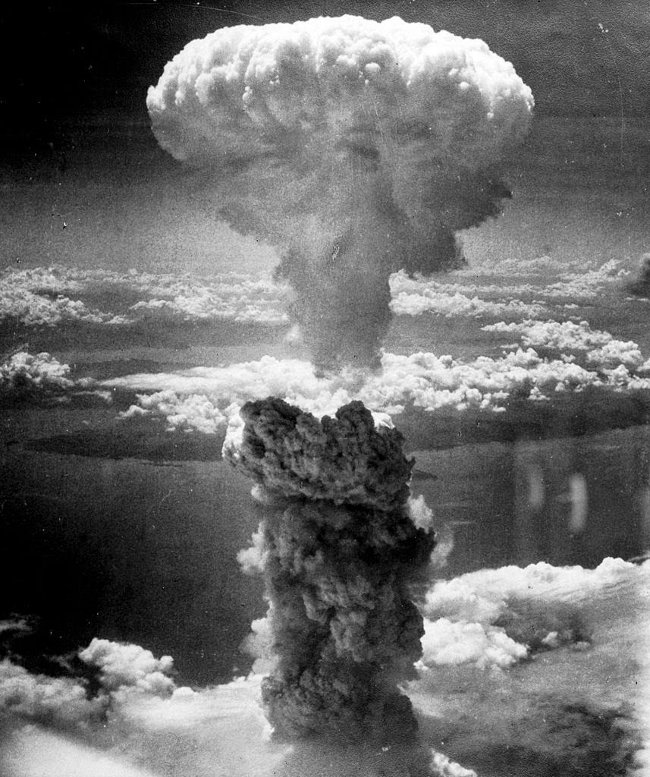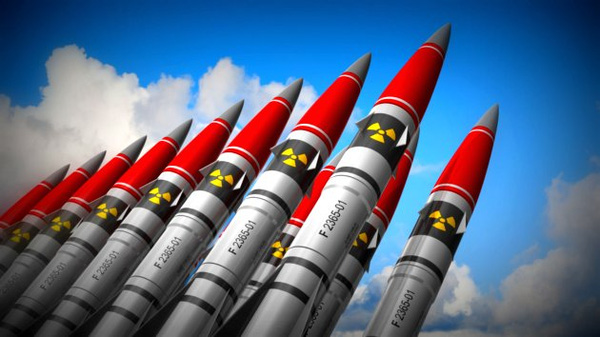Differences between atomic bombs and fusion
These are the two most powerful nuclear weapons available today. Thermonuclear bombs (H bombs) are believed by scientists to be more powerful but not as common as atomic bombs (A bombs).
Atom bomb
Atomic bombs operate on the principle of decomposing heavy - unstable nuclei such as uranium or plutonium into lighter nuclei and release energy.

Nuclear bomb explosion in Nagasaki on August 9, 1945.(Photo: Wikipedia).
The atomic bomb explosion takes place in a chain reaction , starting when a neutron (electrically neutral particle in the atomic nucleus) collides with a nucleus of uranium or plutonium, causing the nucleus to break down into integers. more durable element (usually barium and krypton).
This process releases energy in the form of heat, gamma ray radiation and some neutrons. These neutrons repeat the process until the reactive fuel runs out. This chain reaction takes place in a very short time, about a millionth of a second. The destructive power of an atomic bomb is equivalent to 1,000 tons (1 KT) to several hundred thousand tons of TNT.
For each type of fuel the atomic bomb has a characteristic mass, called critical mass . When the volume of fuel is smaller than this mass, the chain reaction does not occur. Reactive fuel in each bomb will be split into the lower parts to ensure safety. If you want to detonate, just separate these individual parts into one block. This mass of pure uranium 235 is 50kg.
So far, the United States is the only country that uses atomic bombs during the war. The first bomb that the US dropped on Hiroshima on August 6, 1945 had a power of about 15 KT, the second dropped on Nagasaki three days later with about 20 KT. This was part of the results of the Manhattan research project on nuclear weapons in World War II.

Two ways to detonate an atomic bomb.(Photo: Wikipedia).
Fusion bomb
Researched by the United States in the early 1950s, thermonuclear bombs were thought to have been more powerful than thousands of times the atomic bombs.
The basic difference between the two types is that thermonuclear bombs release energy from the process of synthesizing two light nuclei (hydrogen) into a heavier nucleus (helium). This is also the reaction that is happening on the Sun.
However, since the nuclei are positively charged and repel each other, there must be a very high energy, or a very high temperature, to bring them close enough to occur nuclear fusion. This condition can only be achieved by detonating an atomic bomb.
Thus, a thermonuclear bomb is a double bomb , first to explode the atomic bomb to facilitate the fusion reaction to occur.

The process of synthesizing two isotope nuclei of hydrogen (deuterium and tritium) into helium and release energy in the fusion reaction.(Photo: Chemwiki).

Compare the power of atomic bombs and thermonuclear bombs - (Graphic: VNA)
How destructive is a thermonuclear bomb?
The energy released from a fusion explosion can instantly destroy everything within a few kilometers radius. Extreme heat can cause fire storms; High intensity white light from the explosion can cause blindness. Radioactive dust and reaction products such as cesium-137 and strontium-90 can poison living organisms, air pollution, soil and water sources for hundreds of years.
Current technology has enabled the creation of thermonuclear warheads small enough to attach to ballistic missiles or artillery shells.
Thermonuclear bombs have thousands of times more destructive power than normal atomic bombs. According to military experts, an atomic bomb has only power in kilotons (1 kiloton equals 1,000 tons of TNT).
In the meantime, the explosive power (explosive equivalent) of a normal thermonuclear bomb will be calculated in megatons - equivalent to millions of tons of TNT.

Historically, the first US "hydrogen bomb" bomb tested by the US in 1952 has a powerful power of 10.4 megatons, creating a calorific impact within a radius of 56km. Meanwhile, the Fat Man - which killed 40,000 people in Nagasaki - had only about 21 kilotons.
What is the difference between the North Korean bomb?
However, in Korea's announcement there is a notable point, which is that they successfully tested: " miniaturized H-bomb ". And if that is true, the situation is much more serious.

Illustration
Why so? The "miniaturization" technique - has been applied to nuclear weapons for decades, to bring nuclear warheads into long-range missiles.
And if the nuclear warhead is replaced with H bombs, this means that even countries with terrible military potential are under threat.
There are 9 countries that claim to have nuclear weapons, including the United States, Britain, France, Russia, China, India, Pakistan and Korea. In particular, only 5 countries of America, England, France, Russia and China have thermonuclear bombs. North Korea recently announced a thermonuclear bomb, but there is no concrete evidence. Iran and Syria have been accused of storing nuclear weapons by the US.
Concerned about the risk of nuclear war, Nuclear Non-Proliferation Treaty (NPT) has been signed by many countries since 1968, to prevent widespread dissemination and possession of this weapon, and at the same time. Encourage research using nuclear technology for peaceful purposes. So far 190 countries have participated. Vietnam joined in 1981.
- To destroy the world, only 10 fusion bombs are needed
- The attempt to have an American plane to lose an atomic bomb
- Learn production processes and nuclear bomb power
- China aspires to build the world's strongest neutron beam
- Cruel traces of atomic bombs
- Decode the most terrible atomic bomb series in history
- US spends $ 1,000 billion developing smart nuclear bombs
- Why can't we defeat storms with atomic bombs?
- January 3: Confidential information about the creation of an atomic bomb stolen by the Soviet Union
- Listed the 7 most evil weapons in human history
- The most atomic bombing place on the planet: 10,000 years of danger!
- The shocking truth about the 'father' of the atomic bomb
 'Fine laughs' - Scary and painful torture in ancient times
'Fine laughs' - Scary and painful torture in ancient times The sequence of numbers 142857 of the Egyptian pyramids is known as the strangest number in the world - Why?
The sequence of numbers 142857 of the Egyptian pyramids is known as the strangest number in the world - Why? History of the iron
History of the iron What is alum?
What is alum?